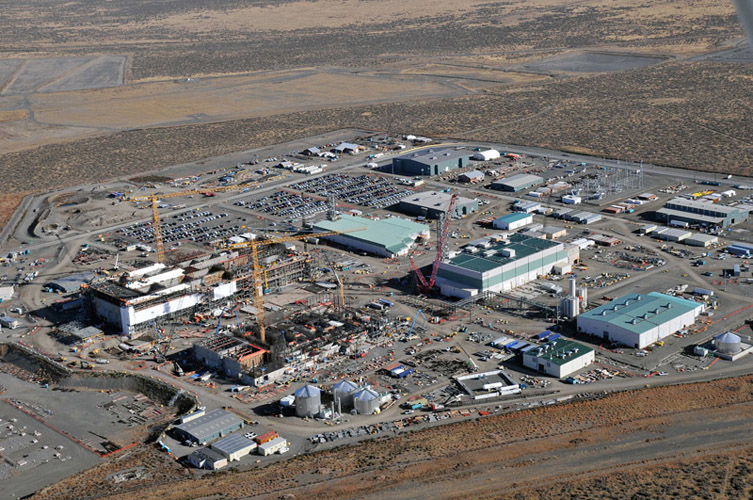Two new reports shed light on Hanford’s tank waste challenges -- ANS / Nuclear Newswire

Hanford’s Waste Treatment and Immobilization Plant. (Photo: DOE)
A pair of recent reports by the U.S. Government Accountability Office and the National Academies of Science, Engineering, and Medicine highlight some of the challenges the Department of Energy faces in treating the millions of gallons of legacy radioactive waste at the Hanford Site in Washington state.
Both reports focus on recent efforts by the DOE to assess possible alternatives to vitrifying Hanford’s 54 million gallons of liquid tank waste, immobilizing it in a solid glass form. The DOE has long intended to vitrify all the tank waste after separating it into high- and low-level radioactive waste streams. That plan, however, may not be feasible, as the DOE continues to face technical problems, cost overruns, and schedule delays with building the site’s Waste Treatment and Immobilization Plant (WTP).
The issues: According to the GAO, construction of the WTP’s Pretreatment Facility, which would separate the waste streams, and High-Level Waste Facility, which would vitrify the HLW, cannot be completed as planned due to technical issues. Completing the facilities as planned, the GAO said, would be cost and schedule prohibitive.
Likewise, the WTP’s Low-Activity Waste Facility, which is currently being commissioned, does not have the capacity to vitrify all of Hanford’s LLW, and the DOE is seeking alternatives for treating the remaining waste, referred to as supplemental low-activity waste (SLAW). The DOE is currently reviewing the possibility of solidifying Hanford’s SLAW in grout and disposing of it on site, at an outside facility, or a combination of both.
The DOE is also negotiating with the Washington State Department of Ecology and the Environmental Protection Agency on revising court-mandated deadlines for treating Hanford’s tank waste.
High-level waste: The GAO report, Hanford Cleanup: DOE Should Validate its Analysis of High-Level Waste Treatment Alternatives, assesses the DOE’s consideration of 24 options for treating Hanford’s HLW. Those options were outlined in an analysis of alternatives report released by the DOE in January. The analysis also found that the life-cycle cost estimates for treating the HLW ranged from $135 billion to $5 trillion.
While the DOE plans to select an alternative for HLW treatment in the near future, the GAO found that the DOE has not committed to validating its analysis of alternatives. “Given the enormous cost and schedule implications of the decision, it is essential for DOE to take steps now to provide assurance that all viable alternatives for optimizing the tank waste treatment mission are considered,” the GAO said in its report.
The DOE agreed with the GAO’s recommendation to obtain an independent review of the department’s analysis of HLW treatment alternatives, adding that actions the department has and will take satisfy the recommendation. The GAO, however, said it believes further action is needed.
Low-level waste: The NASEM report, Review of the Continued Analysis of Supplemental Treatment Approaches of Low-Activity Waste at the Hanford Nuclear Reservation, which is still in prepublication as of this writing, is the third and final report on the organization’s review of an analysis of options for treating Hanford’s SLAW. As directed by law, that analysis was conducted by a federally funded research and development center (FFRDC) led by Savannah River National Laboratory.
The FFRDC selected four alternative approaches to treating the SLAW, with a baseline alternative of vitrification with disposal at Hanford’s on-site disposal facility. The three other alternatives include solidification through steam reforming (similar to that of Idaho’s Integrated Waste Treatment Unit) with on-site disposal, off-site grouting and disposal, and a phased approach that begins with off-site grouting and disposal and transitions to on-site operations.
According to the NASEM, the FFRDC has made a strong technical case that off-site grouting and disposal is for the most part the preferred option, and may be a technically valid option with on-site disposal if found acceptable from a waste acceptance standpoint.
The NASEM also found that “a clear and persistent difference exists” between grouting and vitrification and steam reforming, and that grouting “dominates the other two alternatives on the basis of lower cost and shorter time to operational startup”.
Before reaching a decision on specific alternatives, the NASEM said that a detailed analysis will still be needed for a wider variety of grouting options. This includes the location of grouting plants, the possibility of on-site commercial SLAW facilities, and a detailed assessment of the waste acceptance criteria, cost, and other aspects of off-site treatment or disposal, including regulatory and public acceptance.
- Log in to post comments


